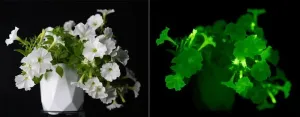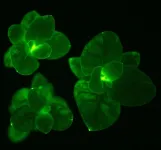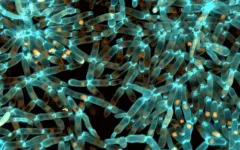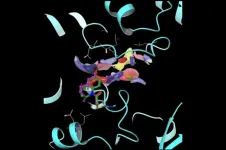(Press-News.org) A team of physicists has developed a method to detect gravity waves with such low frequencies that they could unlock the secrets behind the early phases of mergers between supermassive black holes, the heaviest objects in the universe.
The method can detect gravitational waves that oscillate just once every thousand years, 100 times slower than any previously measured gravitational waves.
“These are waves reaching us from the farthest corners of the universe, capable of affecting how light travels,” said Jeff Dror, Ph.D., an assistant professor of physics at the University of Florida and co-author of the new study. “Studying these waves from the early universe will help us build a complete picture of our cosmic history, analogous to previous discoveries of the cosmic microwave background.”
Dror and his co-author, University of California, Santa Cruz postdoctoral researcher William DeRocco, published their findings Feb. 26 in Physical Review Letters.
Gravitational waves are akin to ripples in space. Like sound waves or waves on the ocean, gravitational waves vary in both frequency and amplitude, information that offers insights into their origin and age. Gravitational waves that reach us can be oscillating at extremely low frequencies, much lower than those of sound waves detectable with the human ear. Some of the lowest frequencies detected in the past were as low as one nanohertz.
“For reference,” Dror explained, “the frequency of sound waves created by an alligator roar are about 100 billion times higher than this frequency – these are very low-pitched waves.”
Their new method of detection is based on analyzing pulsars, neutron stars that emit radio waves at highly regular intervals. Dror hypothesized that searching for gradual slowdown in the arrivals of these pulses could reveal new gravitational waves. By studying existing pulsar data, Dror was able to search for gravitational waves with lower frequencies than ever before, increasing our “hearing range” to frequencies as low as 10 picohertz, 100 times lower than previous efforts that detected nanohertz-level waves.
While gravitational waves with frequencies around a nanohertz have been detected before, not much is known about their origin. There are two theories. The leading idea is that these waves are the result of a merger between two supermassive black holes, which, if true, would give researchers a new way to study the behavior of these giant objects that lie at the heart of every galaxy.
The other main theory is that these waves were created by some sort of cataclysmic event early in the universe’s history. By studying gravitational waves at even lower frequencies, they may be able to differentiate these possibilities.
“Looking ahead, the next step is to analyze newer data sets,” Dror said. “The datasets we used were primarily from 2014 and 2015, and a huge number of pulsar observations have been undertaken since that time.”
Dror also plans to run simulations on mock data using UF’s HiPerGator supercomputer to further unravel cosmic history. The supercomputer can efficiently run large, complex simulations, significantly reducing the time required to analyze data.
This study was supported in part by the National Science Foundation and the Department of Energy.
END
Pushing the boundary on ultralow frequency gravitational waves
Lowest-ever frequency gravitational waves spotted in pulsar data
2024-03-08
ELSE PRESS RELEASES FROM THIS DATE:
New study reveals molecular fingerprint of biological aging
2024-03-08
University of Pittsburgh researchers have uncovered blood-based markers linked with healthy and rapid aging, allowing them to predict a person’s biological age — how fast a person’s cells and organs age regardless of their birthdate.
The new research, published in Aging Cell, points to pathways and compounds that may underlie biological age, shedding light on why people age differently and suggesting novel targets for interventions that could slow aging and promote healthspan, the length of time a person is healthy.
“Age is more than just a number,” said senior author Aditi Gurkar, Ph.D., assistant professor of geriatric medicine at ...
Glowing flowers illuminate homes and gardens with organic light
2024-03-08
Sun Valley, ID - March 8, 2024 – Recent discoveries published in Science Advances have unveiled a native plant gene that enables researchers to more effortlessly harness the captivating glow of bioluminescent plants. This gene, which varies across different plant species, allows for the redirection of living energy into organic light. The advancement reveals the intricate inner rhythms and dynamics of plants through continuously evolving luminosity, offering a natural source of illumination for homes, gardens, and beyond.
The study received support from Light Bio, a pioneer in the development of bioluminescent plants. Light Bio is dedicated to fostering ...
Research sheds light on new strategy to treat infertility
2024-03-08
New research from Oregon Health & Science University describes the science behind a promising technique to treat infertility by turning a skin cell into an egg that is capable of producing viable embryos.
Researchers at OHSU documented in vitro gametogenesis, or IVG, in a mouse model through the preliminary steps of a technique that relies upon transferring the nucleus of a skin cell into a donated egg whose nucleus has been removed. Experimenting in mice, researchers coaxed the skin cell’s nucleus into reducing its chromosomes by half, so that it could then be fertilized ...
The brain builds emotions regardless of the senses
2024-03-08
How much do our emotions depend on our senses? Does our brain and body react in the same way when we hear a fearful scream, see an eerie shadow, or smell a sinister odor? And does hearing an upbeat music or seeing a colorful landascape bring the same joy?
In an innovative study published in Science Advances, researchers have unveiled new insights into the intricate relationship between emotion and perception.
Led by a team of Italian neuroscientists from the IMT School for Advanced Studies Lucca, and conducted in collaboration with the University of Turin, the research project investigates whether the brain employs sensory-specific or abstract codes to construct ...
Harnessing the mechanisms of fungal bioluminescence to confer autonomous luminescence in plants and animal cells
2024-03-08
In a striking new study published today in Science Advances, a team of synthetic biologists led by Karen Sarkisyan at the MRC Laboratory of Medical Sciences, have reported the discovery of multiple plant enzymes – hispidin synthases – that can perform the most complex reaction of the bioluminescence pathway. This discovery is a significant milestone towards figuring out whether plants can natively produce all the molecules required for light emission. It also means that the glow of bioluminescent plants can now be more closely aligned with their internal biology.
The technology reported in the paper is a hybrid ...
New study discovers how altered protein folding drives multicellular evolution
2024-03-08
Researchers have discovered a mechanism steering the evolution of multicellular life. They identified how altered protein folding drives multicellular evolution.
In a new study led by researchers from the University of Helsinki and the Georgia Institute of Technology, scientists turned to a tool called experimental evolution. In the ongoing Multicellularity Long Term Evolution Experiment (MuLTEE), laboratory yeast are evolving novel multicellular functions, enabling researchers to investigate how they arise.
The study puts the spotlight on the regulation of proteins in understanding evolution.
"By demonstrating the effect of protein-level ...
Socially prescribed creative play boosts parents’ and children’s wellbeing
2024-03-08
University of Leeds news
For immediate release
Socially prescribed creative play boosts parents’ and children’s wellbeing
Socially prescribed creative play helps children and their parents develop new skills and promotes wellbeing, a new study has found.
The University of Leeds-led study evaluated a five-week programme of arts-based play, including singing and music-making, for families of children aged up to three. It found that parents benefited from developing social networks and sharing experiences with each other, as well as learning creative approaches to parenting. ...
Researchers’ approach may protect quantum computers from attacks
2024-03-08
Quantum computers, which can solve several complex problems exponentially faster than classical computers, are expected to improve artificial intelligence (AI) applications deployed in devices like autonomous vehicles; however, just like their predecessors, quantum computers are vulnerable to adversarial attacks.
A team of University of Texas at Dallas researchers and an industry collaborator have developed an approach to give quantum computers an extra layer of protection against such attacks. Their solution, Quantum Noise Injection for Adversarial Defense (QNAD), counteracts the impact of ...
Rogue enzymes cause numerous diseases. A new method could help design drugs to treat them.
2024-03-08
Helicases are enzymes that unwind DNA and RNA. They’re central to cellular life, implicated in a number of cancers and infections—and, alas, extraordinarily difficult to target with drugs.
Now, new research provides a powerful platform for designing covalent inhibitors tailored to target helicases. The paper, published in the Journal of the American Chemical Society, describes how researchers used this innovative new platform to design molecules that take aim at helicases involved in COVID and certain cancers.
“High-resolution structural and biochemical data alone are not sufficient ...
Study shows how oestrogen protects against fatty liver
2024-03-08
New research from Karolinska Institutet in Sweden shows how oestrogen protects against MASLD, a fatty liver disease that has increased dramatically during the current obesity epidemic. The study, published in Molecular Systems Biology, shows how a new drug under development could become a future treatment for fatty liver disease and liver cancer.
The global obesity epidemic has resulted in a dramatic increase in fatty liver, a disease in which fat that does not fit into fat cells is stored in liver cells instead.
Since last year, fatty liver due to obesity (and not excessive alcohol consumption) is known as MASLD (metabolic dysfunction-associated steatotic liver disease). ...
LAST 30 PRESS RELEASES:
Key lung immune cells can intensify allergic reactions
Do hormones explain why women experience more gut pain?
New materials conduct ions in solids as easily as in liquids
Breakthrough of the Year: Renewable energy begins to eclipse fossil fuel-based sources
LLM use is reshaping scientific enterprise by increasing output, reducing quality and more
Introducing LightGen, a chip for ultra-fast, ultra-efficient generative AI
Astronomers see fireworks from violent collisions around nearby star
ACC/AHA issue new guideline on managing congenital heart disease in adults
Cosmic crash caught on camera
Is talented youth nurtured the wrong way? New study shows: top performers develop differently than assumed
Ants: An untapped resource in the development of antibiotics?
Archaeologists use AI to create prehistoric video game
Mitochondria migrate toward the cell membrane in response to high glucose levels
Tiny viral switch offers hope against drug-resistant bacteria
Most parents aware of early peanut introduction guidelines, but confused about details
HPV vaccine can protect against severe lesions of the vulva and vagina
Virtual care provision and emergency department use among children and youth
Quadrivalent HPV vaccine and high-grade vulvovaginal lesions
Insights into dry eyes gained from stem cell-derived tear glands
Researchers identify 166 human pluripotent stem cell lines available for use in clinical applications
Europa Clipper instrument uniquely observed interstellar comet 3I/ATLAS
UN University Report challenges climate change as sole trigger of Syrian Civil War, exposing governance failures in drought response
Real estate investment trust (REIT) acquisition associated with hospital closure and bankruptcy
New Raman imaging system detects subtle tumor signals
Boston Children’s receives a $7.5 million grant from Aligning Research to Impact Autism (ARIA) to provide clinical research coordination for the IMPACT Network
Spray-on antibacterial coating offers new protection for plants against disease and drought
ESMT Berlin study: What makes a first offer successful in negotiations
Groundbreaking ceremony marks the beginning of CTAO-South Array construction in Chile
Why swearing makes you stronger
What prevents more cancer patients from enrolling in potentially life-saving clinical trials?
[Press-News.org] Pushing the boundary on ultralow frequency gravitational wavesLowest-ever frequency gravitational waves spotted in pulsar data





